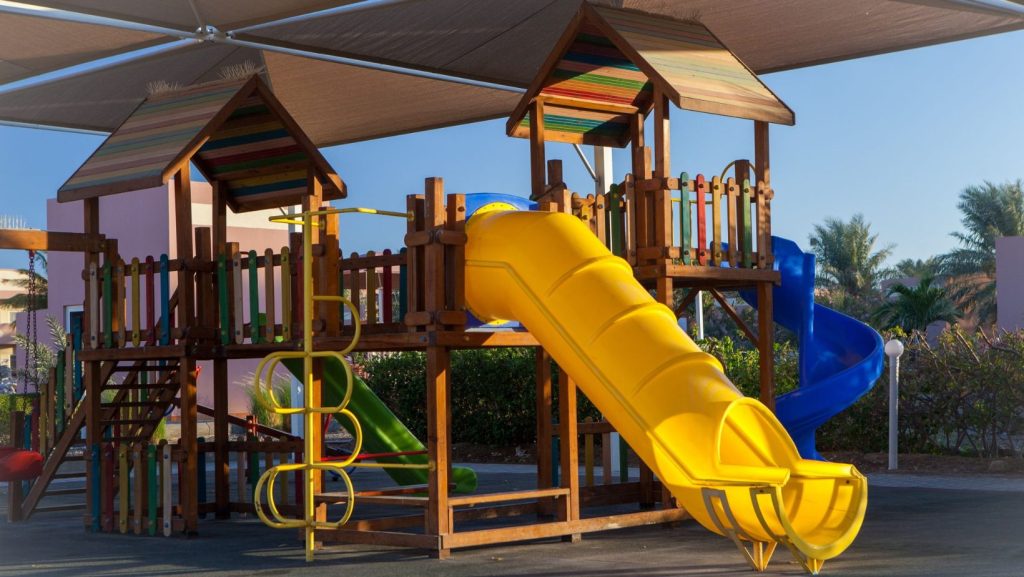
Playgrounds are so much more than physical installations; they’re spaces where creativity flourishes, friendships blossom, and energy finds its outlet. They’re vital environments for children’s development, offering a blend of fun and learning that encourages muscles and minds to grow. But not all playgrounds are created equal.
One key element that turns an ordinary playground into an extraordinary experience? Color. The deliberate use of color in playground equipment doesn’t just make structures visually appealing—it creates an environment that stimulates imagination, encourages activity, fosters inclusion, and provides safety cues. Understanding how to harness color can make all the difference in a child’s play experience.
The Psychology of Color and Play
Colors don’t just create visual appeal; they spark emotions, shape perceptions, and influence behaviors—particularly in children, whose curiosity and imagination are still being developed. Specific colors evoke unique emotional and mental responses that can shape how children interact with playground equipment.
Vibrant Colors, Endless Energy
Bright reds, yellows, and oranges create feelings of excitement and energy. These colors are perfect for areas meant for active play, such as climbing walls, slides, or monkey bars. When kids encounter these hues, they instinctively associate them with activity and fun.
Calm and Tranquil Tones
Cooler shades like blues and greens have the opposite effect. They evoke feelings of serenity and balance, making spaces feel peaceful and welcoming. Seating areas or quiet play zones designed with these hues can help children relax and recharge before their next playful adventure.
Neutral Breaks for Balance
White, gray, or beige tones act as grounding colors that balance the vibrancy of brighter hues. Their neutrality provides a visual “break,” ensuring that the overall space isn’t overwhelming.
Shaping Experience Through Intentional Colors
A playground that uses color strategically can foster specific types of activity. For example, an outdoor learning space painted in calm tones could enhance focus and connection to nature, while zones filled with bold red and yellow hues encourage boisterous games and creativity.
By tailoring color choices to reflect the purpose of different zones, playground designers can build spaces that not only look great but also support developmental goals.
Enhancing Safety Through Color
Beyond aesthetics and stimulation, color plays an important role in making playgrounds safer for children. Thoughtful color choices can visually guide kids and caregivers, reducing the risk of accidents while improving accessibility.
Visibility Saves Lives
Brightly colored equipment is easier to spot from afar, offering peace of mind to caregivers and helping children understand their surroundings. For instance, vibrant yellow or orange slides stand out against lush green grass, ensuring they’re seen clearly.
Color-Coded Safety Markers
Using high-contrast shades on steps, edges, and boundaries can prevent trips and falls. For example, outlining stairs in bold tones like black and yellow alerts children to their presence. This visual cue makes the equipment intuitive and user-friendly for kids of all ages.
Inclusivity Through Visual Design
Color can make outdoor playgrounds more inclusive for children with visual impairments or sensory sensitivities. Highly contrasting colors can help children with reduced vision distinguish between structures. Meanwhile, sticking to smooth color transitions or muted tones in sensory spaces can create a soothing environment for neurodiverse children.
When utilized thoughtfully, color becomes not just a design choice but a proactive safety feature that accommodates children’s diverse needs.
Designing Color Schemes for Maximum Engagement
Building a playground color scheme isn’t just about throwing bright colors onto equipment and hoping for the best. A deliberate, well-designed scheme enhances the overall experience, providing visual harmony as well as functional organization—all while inspiring greater engagement.
Balance Excitement and Calm
Too many bold or bright tones can lead to overstimulation, particularly for younger kids. Striking the right balance between energetic hues (like red, yellow, and orange) and soothing tones (such as blue and green) can ensure a cohesive space that keeps children happy without overwhelming their senses.
Fit the Theme or Space
Designing with the environment in mind enhances the playground’s connection to its surroundings. For example:
- A jungle-themed playground might incorporate earthy greens, wood-inspired browns, and accent pops of orange and yellow to mimic tropical wildlife.
- A modern urban setting might use sleek tones like gray, white, and navy blue with vibrant pops of orange for a contemporary aesthetic.
Matching the color palette to the location or chosen theme creates a seamless, pleasing integration with the environment.
Organize Zones with Color
Color is a powerful tool for visually defining areas within a playground. For example:
- Use dynamic reds and yellows to highlight areas for physical activity, like climbing frames.
- Apply cool greens or blues to seating or shaded zones where children and families can relax.
- Color-code activity zones, such as green for quiet areas, orange for swinging, or purple for balance beams, to make navigation intuitive for younger children.
The Power of Color in Play Spaces
Color is a bridge between functionality and fun, turning ordinary playground equipment into imaginative spaces where children can thrive. From inspiring creativity and shaping activity to enhancing safety and inclusivity, the power of color goes beyond aesthetics—it’s a vital tool in crafting engaging and accessible playgrounds for communities.
Whether you’re a school administrator, city planner, or playground designer, careful consideration of color can transform your space into a beacon of fun, safety, and creativity for children of all abilities.
Interested in creating an unforgettable play experience? Contact our team of experts today for a consultation and see how our team can help bring your playground vision to life!